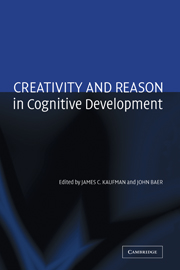Book contents
- Frontmatter
- Contents
- List of Contributors
- Acknowledgments
- Creativity and Reason in Cognitive Development
- Introduction
- COGNITIVE PERSPECTIVES
- DEVELOPMENTAL AND EDUCATIONAL PERSPECTIVES
- 12 Creativity in Young Children's Thought
- 13 A Young Artist's Story: Advancing Knowledge and the Development of Artistic Talent and Creativity in Children
- 14 Is It Reasonable to Be Creative?
- 15 Does Culture Always Matter: For Creativity, Yes, for Deductive Reasoning, No!
- 16 Higher Level Thinking in Gifted Education
- 17 The Relationship Among Schooling, Learning, and Creativity: “All Roads Lead to Creativity” or “You Can't Get There from Here”?
- 18 How Early School Experiences Impact Creativity: An Ecological Perspective
- 19 Conclusions
- Author Index
- Subject Index
- References
12 - Creativity in Young Children's Thought
Published online by Cambridge University Press: 19 January 2010
- Frontmatter
- Contents
- List of Contributors
- Acknowledgments
- Creativity and Reason in Cognitive Development
- Introduction
- COGNITIVE PERSPECTIVES
- DEVELOPMENTAL AND EDUCATIONAL PERSPECTIVES
- 12 Creativity in Young Children's Thought
- 13 A Young Artist's Story: Advancing Knowledge and the Development of Artistic Talent and Creativity in Children
- 14 Is It Reasonable to Be Creative?
- 15 Does Culture Always Matter: For Creativity, Yes, for Deductive Reasoning, No!
- 16 Higher Level Thinking in Gifted Education
- 17 The Relationship Among Schooling, Learning, and Creativity: “All Roads Lead to Creativity” or “You Can't Get There from Here”?
- 18 How Early School Experiences Impact Creativity: An Ecological Perspective
- 19 Conclusions
- Author Index
- Subject Index
- References
Summary
Adam (age 2-1/2) was taking a bath, and his mother said, “I'm going to get the shampoo” as she reached for the bottle of shampoo, which had a cap in the form of Winnie-the-Pooh's head. Adam replied, without missing a beat, “I want sham-piglet,” pointing at the bottle of bath bubbles, which had a cap in the form of Piglet's head (Gelman, 2003, p. ⅷ).
A conversation between a child (age 2 years) and her father:
Sharon
“I pretend the sand is a birthday cake!”
Father
“The sand is a birthday cake?”
Sharon
“I preTEND.” (Gottfried, unpublished data)
Stephanie (age 3-1/2) had been playing with a set of Duplo blocks that included stylized animal faces. The dog and cat were nearly identical; only the cat had eyelashes. Later that day, Stephanie announced that “hes” don't have eyelashes; only “shes” have eyelashes. Stephanie's mother then asked her husband to come into the room and take off his glasses. “Look at Daddy,” she said. “Does he have eyelashes?” Stephanie looked right into his eyes (framed by dark eyelashes) and said, “No. Daddy's a ‘he,’ and ‘hes’ don't have eyelashes” (Gelman, 2003, p. ⅷ).
“Do animals like pomegranates?” (Abe, age 2;11; Gelman, 2003, p. 205).
Although this chapter concerns creativity, we do not consider ourselves to be “creativity researchers” – that is, we do not study creativity per se. Rather, we are developmental psychologists who study children's concepts. However, we argue in this chapter that young children's ordinary thought entails a considerable degree of creativity.
- Type
- Chapter
- Information
- Creativity and Reason in Cognitive Development , pp. 221 - 243Publisher: Cambridge University PressPrint publication year: 2006
References
- 2
- Cited by



